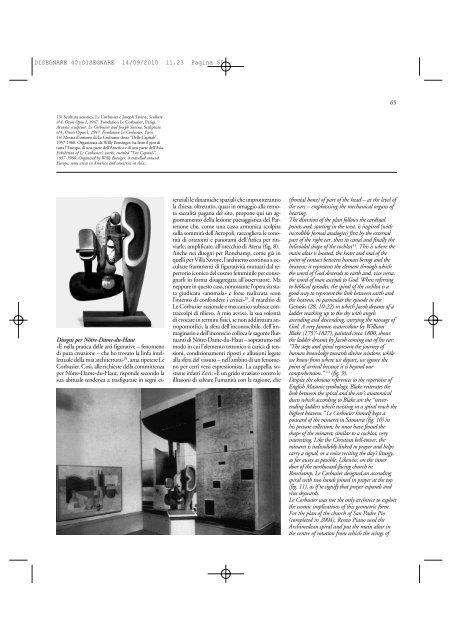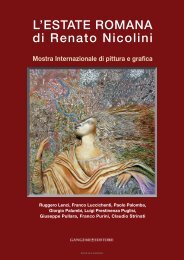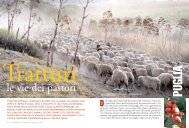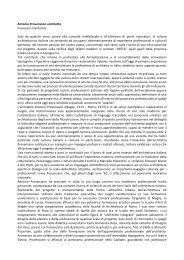Recondite Armonie - Archiwatch
Recondite Armonie - Archiwatch
Recondite Armonie - Archiwatch
Create successful ePaper yourself
Turn your PDF publications into a flip-book with our unique Google optimized e-Paper software.
DISEGNARE 40:DISEGNARE 14/09/2010 11.23 Pagina 65<br />
65<br />
13/ Scultura acustica. Le Corbusier e Joseph Savina, Sculture<br />
n°4, Ozon Opus I, 1947. Fondation Le Corbusier, Parigi.<br />
Acoustic sculpture. Le Corbusier and Joseph Savina, Sculpture<br />
n°4, Ozon Opus I, 1947. Fondation Le Corbusier, Paris.<br />
14/ Mostra d’insieme di Le Corbusier detta “Delle Capitali”,<br />
1957-1960. Organizzata da Willy Boesinger, ha fatto il giro di<br />
tutta l’Europa, di una parte dell’America e di una parte dell’Asia.<br />
Exhibition of Le Corbusier’s works, entitled “Ten Capitals”,<br />
1957-1960. Organised by Willy Boesiger, it travelled around<br />
Europe, some areas in America and countries in Asia.<br />
Disegni per Nôtre-Dame-du-Haut<br />
«È nella pratica delle arti figurative – fenomeno<br />
di pura creazione – che ho trovato la linfa intellettuale<br />
della mia architettura» 28 , ama ripetere Le<br />
Corbusier. Così, alle richieste della committenza<br />
per Nôtre-Dame-du-Haut, risponde secondo la<br />
sua abituale tendenza a trasfigurare in segni essenziali<br />
le dinamiche spaziali che impronteranno<br />
la chiesa; oltretutto, quasi in omaggio alla remota<br />
sacralità pagana del sito, propone qui un aggiornamento<br />
della lezione paesaggistica del Partenone<br />
che, come una cassa armonica scolpita<br />
sulla sommità dell’Acropoli, raccoglieva le sonorità<br />
di orizzonti e panorami dell’Attica per rinviarle,<br />
amplificate, all’orecchio di Atena (fig. 8).<br />
Anche nei disegni per Ronchamp, come già in<br />
quelli per Villa Savoye, l’architetto continua a occultare<br />
frammenti di figuratività mutuati dal repertorio<br />
iconico del cosmo femminile per consegnarli<br />
in forma disaggregata all’osservatore. Ma<br />
neppure in questo caso, nonostante l’opera sia stata<br />
giudicata «anomala» e forse realizzata «con<br />
l’intento di confondere i critici» 29 , il marchio di<br />
Le Corbusier razionale e meccanico subisce contraccolpi<br />
di rilievo. A mio avviso, la sua volontà<br />
di evocare in termini fisici, se non addirittura antropomorfici,<br />
la sfera dell’inconoscibile, dell’immaginario<br />
e dell’inconscio colloca le sagome fluttuanti<br />
di Nôtre-Dame-du-Haut – soprattutto nel<br />
modo in cui l’elemento tettonico si carica di tensioni,<br />
condizionamenti riposti e allusioni legate<br />
alla sfera del vissuto – nell’ambito di un fenomeno<br />
per certi versi espressionista. La cappella, sostiene<br />
infatti Zevi: «È un grido straziato contro le<br />
illusioni di salvare l’umanità con la ragione, che<br />
(frontal bone) of part of the head – at the level of<br />
the ears – emphasising the mechanical organs of<br />
hearing.<br />
The direction of the plan follows the cardinal<br />
points and, starting in the west, is inspired (with<br />
incredible formal analogies) first by the external<br />
part of the right ear, then its canal and finally the<br />
helicoidal shape of the cochlea 32 . This is where the<br />
main altar is located, the heart and soul of the<br />
point of contact between human beings and the<br />
heavens; it represents the element through which<br />
the word of God descends to earth and, vice versa,<br />
the word of man ascends to God. When referring<br />
to biblical episodes, the spiral of the cochlea is a<br />
good way to represent the link between earth and<br />
the heavens, in particular the episode in the<br />
Genesis (28, 10-22) in which Jacob dreams of a<br />
ladder reaching up to the sky with angels<br />
ascending and descending, carrying the message of<br />
God. A very famous watercolour by William<br />
Blake (1757-1827), painted circa 1800, shows<br />
the ladder dreamt by Jacob coming out of his ear:<br />
“The steps and spiral represent the journey of<br />
human knowledge towards divine wisdom; while<br />
we know from where we depart, we ignore the<br />
point of arrival because it is beyond our<br />
comprehension.” 33 (fig. 9).<br />
Despite the obvious references to the repertoire of<br />
English Masonic symbology, Blake reiterates the<br />
link between the spiral and the ear’s anatomical<br />
ducts which according to Blake are the “neverending<br />
ladders which twisting in a spiral reach the<br />
highest heavens.” Le Corbusier himself kept a<br />
postcard of the minaret in Samarra (fig. 10) in<br />
his private collection; he must have found the<br />
shape of the minaret, similar to a cochlea, very<br />
interesting. Like the Christian bell-tower, the<br />
minaret is indissolubly linked to prayer and helps<br />
carry a signal, or a voice reciting the day’s liturgy,<br />
as far away as possible. Likewise, on the inner<br />
door of the northward-facing church in<br />
Ronchamp, Le Corbusier designed an ascending<br />
spiral with two hands joined in prayer at the top<br />
(fig. 11), as if to signify that prayer expands and<br />
rises skywards.<br />
Le Corbusier was not the only architect to exploit<br />
the cosmic implications of this geometric form.<br />
For the plan of the church of San Padre Pio<br />
(completed in 2004), Renzo Piano used the<br />
Archimedean spiral and put the main altar in<br />
the centre of rotation from which the wings of






